At Lapugnoy two Officers and one hundred and twenty men under the command of Capt Edgar Horace Heathcote formed part of a Brigade fatigue party that proceeded in buses to Sailly Labourse and were employed in removing gas apparatus from the trenches that had recently been used in the battles around Loos. This fatigue party was relieved on the 25th October by a second similar party, which returned to Bethune on the 29th October.
On Tuesday 26th October, whilst the Battalion was at Bethune, Capt Arthur Hopkins, Lt Joseph Tolsen, 2/Lt William Holderness and a draft of 50 Other Ranks arrived from base.
Joseph Tolson
This was followed on the 1st November by 2/Lt Kenneth Hills Bond and 15 NCO’s and men from the 2nd Entrenching Battalion, and again on the 2nd November by 2/Lt William Duncan Jamieson and a draft of 35 Other Ranks.
During the latter half of 1915 the IV and V Reinforcements arrived in France on 27.10.15 and 10.11.15 respectively. These drafts arrived at the 46th North Midland Base Depot and the men were either posted directly to the 1/6th Battn or to No 2 & 9 Entrenching Battalions until they were needed.
Whilst in Bethune the Battalion, along with the rest of the 46th Division provided composite companies and platoons of men for an inspection by King George V. Unfortunately the inspection was curtailed when the King was thrown from his horse and injured.
 The Battalion moved into billets in Pacaut and it was here that Captain Victor Robinson received notification that he had been awarded the Military Cross for conspicuous gallantry during the attack and subsequent defence of the Hohenzollern Redoubt between the 13th and 15th October.
The Battalion moved into billets in Pacaut and it was here that Captain Victor Robinson received notification that he had been awarded the Military Cross for conspicuous gallantry during the attack and subsequent defence of the Hohenzollern Redoubt between the 13th and 15th October.
La Coutre and Richebourg-L’Avoue
On 6th November the Battalion moved into Brigade Reserve at La Coutre near to Richebourg-L’Avoue in France; a position close to Neuve Chappelle and overlooked by Aubers Ridge.
The move was precipitated in part by the decision to relieve the Indian Corps of further duty on the Western Front before winter set in. In readjusting the front line held by the First Army the XI Corps took over the sector north of La Bassee Canal. The front held by XI Corps now extended from Richebourg-L’Avoue northwards to Picantin village. This section of the front line was situated in low lying country, which would prove to be very uncomfortable for the Companies occupying the front line trenches.
“On the 6th November we returned to the front line trenches, this time at Richebourg-L’Avoue. Here the opposing trenches were about 100 yards apart. And between them was a stream about 20 feet wide which was virtually impregnable as both the British and Germans had filled it with barbed wire”
[1724 Pte Robert F Langley, Robin Hoods]
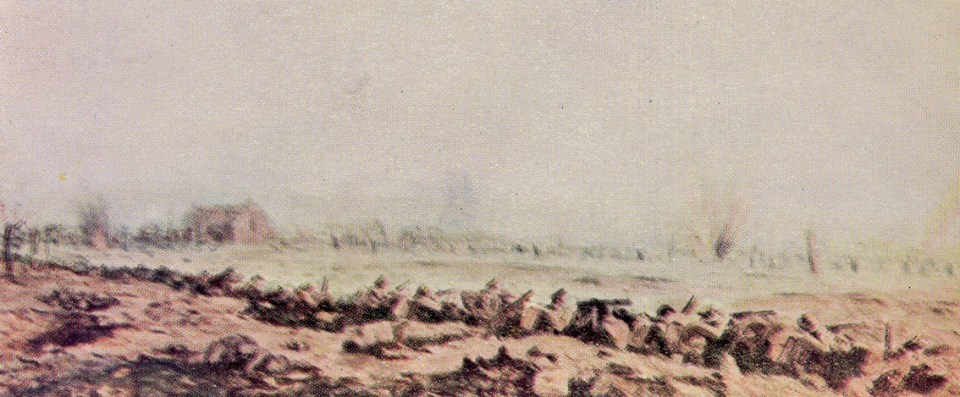 The 2nd Sherwood Foresters in trenches near Neuve Chappelle on 12th March 1915. This drawing clearly shows the flat landscape of this region of France and the shallow trenches which comprised the British firing line.
The 2nd Sherwood Foresters in trenches near Neuve Chappelle on 12th March 1915. This drawing clearly shows the flat landscape of this region of France and the shallow trenches which comprised the British firing line.
18th Trench Duty 9th-13th November 1915
On the 9th November the Battalion relieved the 7th London Regt in ‘Back Posts’, which was in the rear of the Right Sector. From here the Battalion provided working parties to repair the old British fire trench. The following day a draft of 16 men arrived and the Battalion moved to the front line trenches to relieve the 5th Sherwood Foresters in the right sub-sector trenches to the South of Richebourg-L’Avoue, whilst the 7th Sherwood Foresters occupied the left sub-section trenches running north east from Richebourg-L’Avoue.
 On Saturday 13th the Battalion was relieved by the 5th Leicesters and “A”, “B” and “D” Companies moved into billets at La Coutere, whilst “C” Company remained in the front line. The following day “C” Company was relieved by the 7th Sherwood Foresters and joined the rest of the Battalion in La Coutere.
On Saturday 13th the Battalion was relieved by the 5th Leicesters and “A”, “B” and “D” Companies moved into billets at La Coutere, whilst “C” Company remained in the front line. The following day “C” Company was relieved by the 7th Sherwood Foresters and joined the rest of the Battalion in La Coutere.
During that brief trench duty Pte 1896 Reginald Draycott from Old Whittington was killed and 3011 Pte. William Hayes of A Company was wounded.
- 1896 Pte. Reginald DRAYCOTT was a resident of Old Whittington and enlisted in May 1913 aged 17; he served with A Company. Prior to the War Reginald was a Boiler Smith who worked for Sheepbridge Coal & Iron Company. He is Commemorated with Honour on the Old Whittington Memorial.
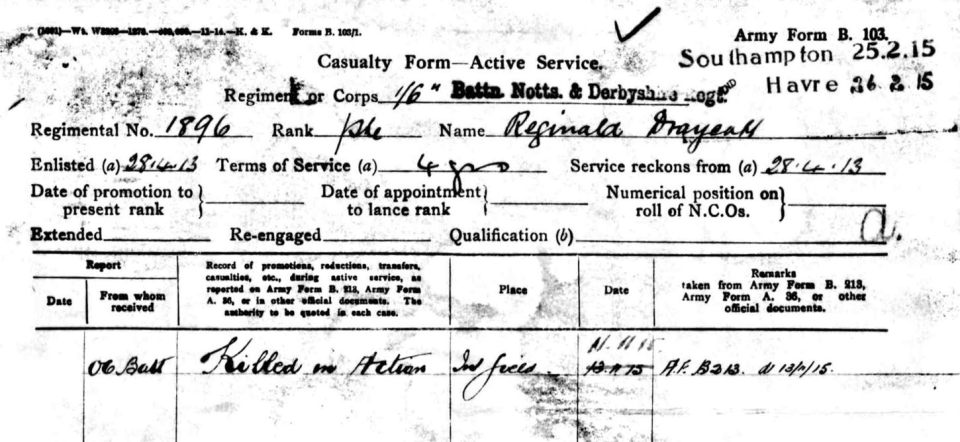
 Reginald Draycott was buried in a ‘trench cemetery’ close to Richebourg-L’Avoue. In total 10 men from the 46th North Midland Division are now buried in Rue-Des-Berceaux Military Cemetery, but Reginald and 2008 Pte. A Wigginton of the 1/5th Lincolns are probably the only original burials because the other 46th Division men are all buried in Plot II, which was a concentration plot made after the War.
Reginald Draycott was buried in a ‘trench cemetery’ close to Richebourg-L’Avoue. In total 10 men from the 46th North Midland Division are now buried in Rue-Des-Berceaux Military Cemetery, but Reginald and 2008 Pte. A Wigginton of the 1/5th Lincolns are probably the only original burials because the other 46th Division men are all buried in Plot II, which was a concentration plot made after the War.
The fact that 2600 Pte Davison of the 1/5th Lincolns has an Edgeware Road Cemetery Memorial suggests that some of the men were exhumed from that trench burial site.
- 2402 Pte ASHTON, 07/11/1915, 1st/5th Bn., Notts and Derby Regiment, II. F. 1.
- 1896 Pte DRAYCOTT, 11/11/1915, 1st/6th Bn., Notts and Derby Regiment I. D. 18.
- 9308 Pte STEVENS, 12/11/1915, 5th Bn., South Staffordshire Regiment, II. E. 46.
- 4210 Pte HARDING, 15/11/1915, 1st/4th Bn., Leicestershire Regiment, I. E. 19.
- 3270 Pte UNWIN, 18/11/1915, 1st/5th Bn., Lincolnshire Regiment, II. D. 41.
- 2292 Pte WARDELL, 19/11/1915, 1st/5th Bn., Lincolnshire Regiment, II. D. 36.
- 2600 Pte DAVISON, 20/11/1915, 1st/5th Bn., Lincolnshire Regiment, Edgware Road Mem. 1.
- 1138 Pte LITHERLANDS, 20/11/1915, 1st/5th Bn., Leicestershire Regiment, II. E. 3.
- 3287 Pte HALE, 23/11/1915, 1st/6th Bn., South Staffordshire Regiment, II. D. 43.
- 2008 Pte WIGGINTON, 28/11/1915, 1st/4th Bn., Lincolnshire Regiment, I. C. 16.

Reinforcements
The following day 2/Lt Thomas Grimshaw arrived with a small draft of 20 Other Ranks followed on the 17th by 2/Lt Victor Hore.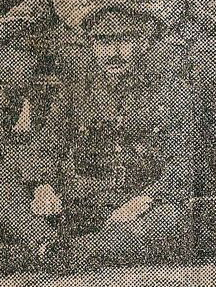
19th Trench Duty 17th-20th November 1915
On the 17th November the Battalion relieved the 7th Sherwood Foresters in the left sub sector trenches; about 300 yards south of the Estaires-La Bassee Road.
 During this time the Battalion Machine Guns were positioned in houses on the Rue-de-Bois reserve trench and were able to fire over the front line trench towards the German positions. The Battalion HQ was placed in a small dug-out behind a ruined farmhouse. Although the dug-out was equipped with beds it was infested with rats and for most of the time it was twelve inches deep in water.
During this time the Battalion Machine Guns were positioned in houses on the Rue-de-Bois reserve trench and were able to fire over the front line trench towards the German positions. The Battalion HQ was placed in a small dug-out behind a ruined farmhouse. Although the dug-out was equipped with beds it was infested with rats and for most of the time it was twelve inches deep in water.
 The weather in November was very wet and bitterly cold, which meant that the front line trenches were nearly 3 feet deep in water in many places and the men often found themselves with water up to their knees. The sandbags on the parapets were in a dreadful state, most of them were rotten allowing the earth to fall out. In many places the parapet collapsed and needed constant repairing. As conditions worsened during November the front line trenches were abandoned in many places and the Companies retired to the reserve trenches leaving listening points behind to maintain contact with the Germans. Although the men were issued with thigh-length wellingtons, on many occasions these proved quite inadequate and the water often came over the top.
The weather in November was very wet and bitterly cold, which meant that the front line trenches were nearly 3 feet deep in water in many places and the men often found themselves with water up to their knees. The sandbags on the parapets were in a dreadful state, most of them were rotten allowing the earth to fall out. In many places the parapet collapsed and needed constant repairing. As conditions worsened during November the front line trenches were abandoned in many places and the Companies retired to the reserve trenches leaving listening points behind to maintain contact with the Germans. Although the men were issued with thigh-length wellingtons, on many occasions these proved quite inadequate and the water often came over the top.
Three days later the Battalion were relieved by the 7th Sherwood Foresters and moved back to billets in La Couture; two men were wounded during the three days the battalion spent in the front line trenches:-
- 3082 Pte. John Whaley of D Company who had enlisted in October 1914 and arrived in France in June 1915 with the II Reinforcement. He was discharged in March 1918 and awarded the Silver War Badge.
- The name of the other wounded man is not known.
Men wounded or taken sick during these few days of rest included:-
2049 Pte Frederick Whitehead a millers labourer from Bakewell was a pre-War Territorial who enlisted in September 1913 and served with “D” Company. He arrived in France with the 46th Division in February 1915 and was admitted to the 1st North Midland Field Ambulance with influenza on the 23rd November. After treatment at the 2nd London Casualty Clearing Station and 23rd General Hospital in Rouen he was posted to the 46th North Midland Base Depot. Frederick rejoined the 1/6th Battalion on the 9th January whilst they were in Marseilles. He was to suffer trench foot in March 1916, and woundings in April 1917 and June 1918.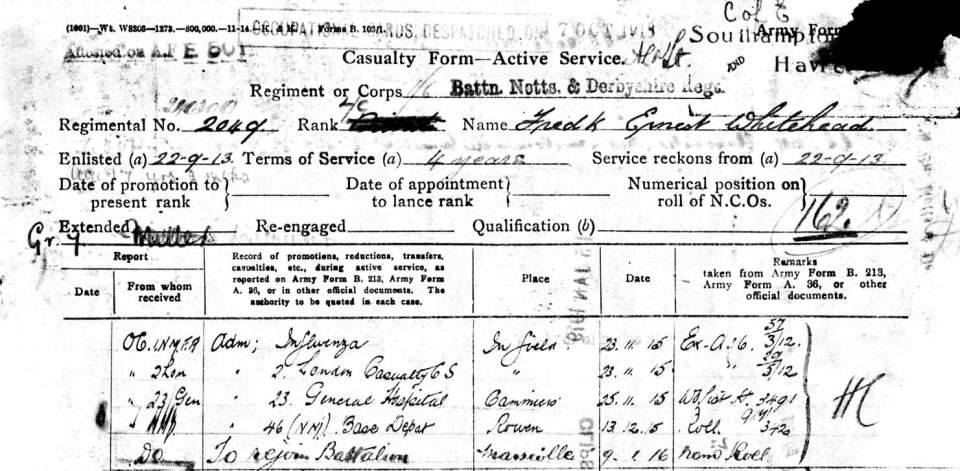
2438 Pte. Harry Eyre a billiard maker from Buxton enlisted on the 7th October 1914 and arrived in the France with the III Reinforcement in August 1915. He was admitted to the 1st North Midland Field Ambulance with a scalded foot on the 24th November and after treatment in the 2nd London Casualty Clearing Station he returned to duty on the 14th December. he later suffered from influenza in February 1917 and was invalided to England. He returned to France with the 35th Reinforcement in June 1917 and was subsequently posted to the 11th Battalion. He was killed in action on the 24th September 1917 by heavy shelling during a trench relief. His body was not recovered and he is now commemorated on the Tyne Cot Memorial. Harry was aged 20 and the Son of Thomas and Jane Eyre of Park Grange in Buxton.
2652 Pte Harold Smith a pottery labourer from Sheepbridge in Chesterfield who enlisted on the 12th October 1915 and arrived in the France with the III Reinforcement in August 1915. Harold returned to England on the 22nd November, but the nature of his wounding/sickness is not known. Harold returned to France with the 9th Reinforcement in May 1916 but was again wounded in January 1917 and transferred to England. Returning to France for a third time in May 1917 he served with the 2/7th, 2/8th and 2/6th Battalions before being transferred to the 22nd London Regiment in August 1918. He was wounded for the last time on the 8th August and returned to England on the 10th October.
3160 Pte Harold Hill a labourer from who enlisted on the 22nd October 1914 and arrived in France with the III Reinforcement in in August 1915. Harold suffered from frost bite and was treated at the 3rd North Midland Field Ambulance and returned to duty on the 5th December. Harold was wounded in April 1917 and killed in action on the 3rd October 1918. He has no known grange and is Commemorated on the Vis-en-Artois Memorial to the missing.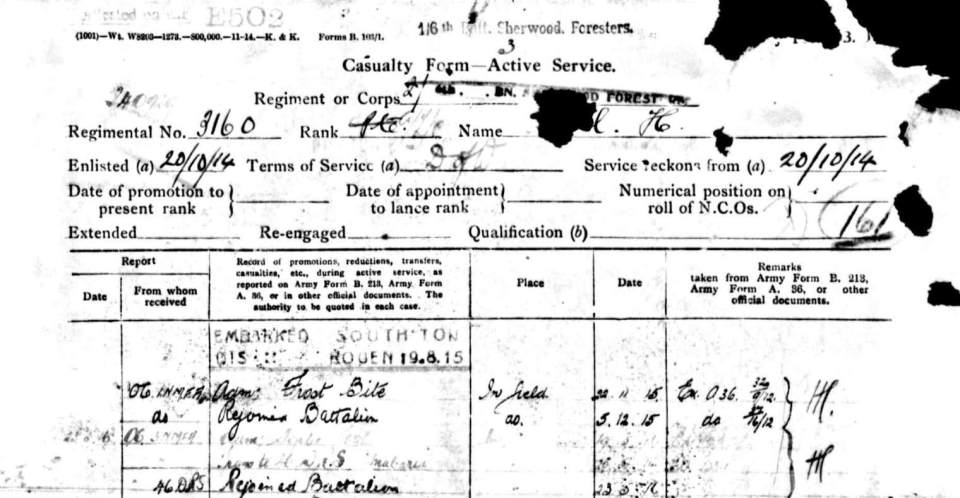
3403 Pte. Alfred Bingley enlisted on the 27th October 1914 and arrived in France with the III Reinforcement in in August 1915. Alfred served with “A” Company and was wounded on the 23rd November. He later served with the Royal Army Medical Corps.
During this period the British High Command considered an attack on the German trenches opposite Richebourg-L’Avoue. This went against the better judgment of Lieut.-Col Wauchope, in command of the 2nd Black Watch, whose men had attacked the same trenches in May, and, along with the Seaforth Highlanders, had suffered over 500 casualties. The attacking Companies were held at the stream by the barbed wire and were forced to retire.
Over the next few days Staff of the 46th Division visited the trench line and were shown the impregnable German positions and crinoline of barbed wire all enfiladed by artillery. Fortunately the Staff Officers agreed with the views expressed by the 139th Brigade Officers and promised to convey the unsuitability of Richebourg-L’Avoue for an attack.
Never-the-less preparations were made should an attack become inevitable. The Brigadier decided that if the Brigade should have to attack the 5th Sherwood Foresters would attack from the left sub-sector trenches with 8th Sherwood Foresters in support. The 6th Sherwood Foresters would attack from the right sub-sector trenches with the 7th Sherwood Foresters in support. To aid in any future attack long planks were brought up by the Battalion transport and these would be laid as gangways across the stream.
20th Trench Duty 23rd-27th November 1915
On the 23rd November the Battalion relieved the 8th Sherwood Foresters in the right sub-sector trenches and it was during this trench duty that a raid was carried out against the German trenches opposite those occupied by the 6th Sherwood Foresters.
This was to be the first of many carefully planned raids that would be carried out by the Battalion over the next 3 years of trench warfare. The raid was carried out from a section of trench known as the Boars Head, which was a group of small strong posts established opposite a small German salient in their front line. The water level in the front line trench had almost risen to ground level and therefore it could not be adequately garrisoned.
 To provide a measure of protection two breastworks had been erected and with the Boars head this formed the British front line position. The majority of the men were placed as support in ruined houses along the Rue-de-Bois and further back near Windy Corner.
To provide a measure of protection two breastworks had been erected and with the Boars head this formed the British front line position. The majority of the men were placed as support in ruined houses along the Rue-de-Bois and further back near Windy Corner.
Lt. Charles Houfton, 8th Sherwood Foresters
Windy Corner was constantly swept by machine gun fire and periodically shelled, particularly when trench relief was being undertaken. It was only possible to visit the detached outposts during the hours of darkness, to do so by day would attract the unwanted attention of German snipers.
This fate befell Lt. Charles Houfton of the 8th Sherwood Foresters who was making his way along a flooded trench to the Boars Head when he was killed by a single shot to the head.
 Lt Charles Morley Houfton was killed on 12th November 1915 and was originally buried close to Windy Corner. He was 28 years old and the Son of John Plowright Houfton and Frances Houfton of Park Hall, Mansfield Woodhouse in Nottinghamshire.
Lt Charles Morley Houfton was killed on 12th November 1915 and was originally buried close to Windy Corner. He was 28 years old and the Son of John Plowright Houfton and Frances Houfton of Park Hall, Mansfield Woodhouse in Nottinghamshire.
 Charles Houfton’s body was exhumed and reburied in 1925. He had originally been buried at Edgware Road No. 4 Cemetery, which was also known as Factory Trench and located at 36. C. 9. A. 90. 45.
Charles Houfton’s body was exhumed and reburied in 1925. He had originally been buried at Edgware Road No. 4 Cemetery, which was also known as Factory Trench and located at 36. C. 9. A. 90. 45.
Visiting the outposts at night still required a careful journey across the Rue-de-Bois and the open ground immediately behind the front line being careful not to fall into the flooded support trenches. On many occasions sporadic machine gun fire required the party to lie prone on the ground until it had finished. The garrisons of the three outposts were relieved every 24 hours because of the strain in occupying these posts when completely isolated and subject to the constantly cold and wet conditions.
Reconnoitring the Boars Head on 25th November 1915
During the evening of the 25th, 1631 L/Sergeant Maurice Limb and 3621 L/Corporal Maurice Rust led two small patrols to either side of the German salient to reconnoiter the ground for an attack the following evening. A patrol of the north side found that the wire and parapet were both good and sound and therefore a decision was made to attack just the south side of the salient where the wire was cut and gaps were present in the parapet.
Bombing enterprise on the 26th November 1915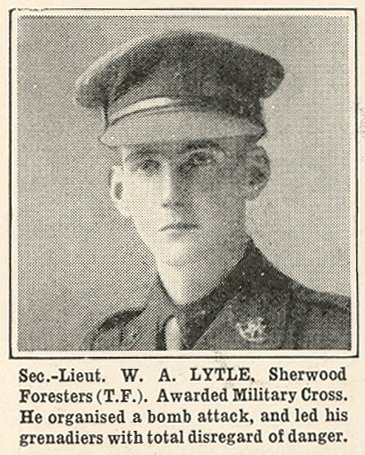
Shortly after 7.30 pm on the following night 2/Lt William Lytle led a small party of bombers across No-Mans-Land and up to the German trenches. The attacking party consisted of ten grenadiers (each carrying 10 Mills bombs) and ten bayonet men (each carrying 5 Mills bombs) together with a Machine Gunner to dismantle any German machine guns that were found.
The official report of the “bombing enterprise” states that all of the men wore the new ‘Brodie’ steel helmets. 2/Lt Lieut Jackson, Sergeant Mathew Unwin and a party of eight Grenadiers of “D” Company garrisoned the Boars Head and covered the advance of the party across No-Mans-Land whilst a machine gun had been firing on the broken wire since 5pm.
A Corporal (most likely Maurice Rust) and two men were sent in advance of the raiding party to check that the wire was still passable, whilst the rest of the party advanced in single file along the side of Boars Head. The men had to go carefully because it was a clear night and the moon was rising. No-Mans-Land was very wet and broken up and the men had to step over numerous dead bodies.
By 8.45pm the whole party was lying about 20 yards in front of the German trenches. From the sound of voices it became clear to William Lytle that the trench was strongly held and had possibly been reinforced following the short British artillery bombardment used to cut the wire. As the party drew close to the German trench they were challenged by the defenders at which point the grenadiers threw their mills bombs and the bayonet party charged. Most of the party reached the top of the parapet and two men even climbed into the trench where they bayoneted three German soldiers. However the men soon found themselves heavily outnumbered and after a further bombing exchange the raiding party withdrew having suffered one man missing and three men wounded. At one point several grenades exploded close to William Lytle and knocked both him and the two N.C.O.s to the ground.

 For their part in the raid Maurice Rust and Maurice Limb both won the Distinguished Conduct Medal, whilst William Lytle received the Military Cross.
For their part in the raid Maurice Rust and Maurice Limb both won the Distinguished Conduct Medal, whilst William Lytle received the Military Cross.
Four other men, 1920 L/Cpl Bert Kensey, 1891 Pte Percy Marper, 3065 Pte Joseph Brown and 4316 Pte James Croxall were all mentioned for having done excellent work.
- 1920 Bert Kinsey was a labourer from New Whittington and attested on 15th May 1913 aged 17. His embodied service began on the 5th August 1914 and he was posted to A Company. He arrived in France on the 28th February 1915 and shortly after taking part in the raid on the Boars head he was sent to the 2nd London CCS and then the 1st Canadian General Hospital suffering from an ulcer on the arm. He rejoined the 1/6th Battn on 9th January 1916 and served in France until the 29th July 1916 when he returned to England for munitions work and was discharged (time expired) on 30th May 1917.

- 1891 Percy Marper enlisted in April 1913 and arrived in France on 28th February 1915. He served with A Company and was wounded on 12th April at Kemmel. He later won the DCM for attacking a machine gun post on 31st August 1918 during operations near Richebourg St Vaast during which time he was badly wounded.
- 4316 James Croxall enlisted in June 1915 and was posted to France on 10th November 1915 with the Vth Reinforcement.
3065 Pte Joseph Brown missing in action
Joseph Brown was last seen bombing in the German trench as the raiding party retired and was reported as missing. His body was never recovered or identified after the war and he is commemorated on the Loos Memorial.
 Army Service record for 3065 Joseph Brown showing that he enlisted into the newly formed 2/6th Battalion on 21st October 1914 aged 19. He arrived in France on the 25th February 1915. Joseph was reported missing on 26th November 1915, but it was not until two months later on the 25th January that he was struck of the strength of the Battalion.
Army Service record for 3065 Joseph Brown showing that he enlisted into the newly formed 2/6th Battalion on 21st October 1914 aged 19. He arrived in France on the 25th February 1915. Joseph was reported missing on 26th November 1915, but it was not until two months later on the 25th January that he was struck of the strength of the Battalion.
In his report of the raid, 2/Lt Lytle noted that none of the grenades were defective, unlike those issued a month previously during the attack on Hohenzollern Redoubt, but that they did not have as strong an explosive force as the German bombs. Never-the-less he still felt that the Mills bomb was more effective because it produced a greater number of ‘splinters’, a fact he’d recognised during the bombing attack on Big Willie a month earlier.
Two days later the Battalion were relieved by the 7th Sherwood Foresters and moved to billets at Vielle Chappelle.
The other men killed during this trench duty were:-
- 3105 Pte James Brocklehurst aged 36 and a miller from Darley Dale who worked at Wheatsheaf Farm near Matlock. James enlisted into the 2/6th Battn on 17th October 1914 and had previously served for 2 years with the Volunteers. He arrived in France on 29th June 1915 with the II Reinforcement and was posted to the No 2 Entrenching Battalion before joining the 1/6th Battn in the field on 16th October 1915.
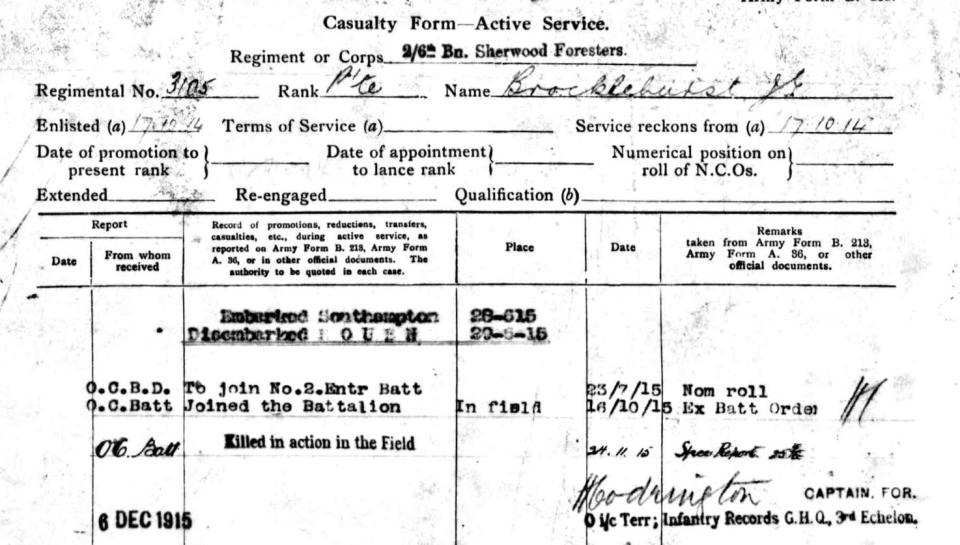 1598 Sergeant George Henry Morley aged 22 and a furnace-man from Brimington who worked at the Staveley Coal and Iron Company. George was a pre-War Territorial and had enlisted in March 1912. He arrived in France with 46th Division in February 1915.
1598 Sergeant George Henry Morley aged 22 and a furnace-man from Brimington who worked at the Staveley Coal and Iron Company. George was a pre-War Territorial and had enlisted in March 1912. He arrived in France with 46th Division in February 1915.
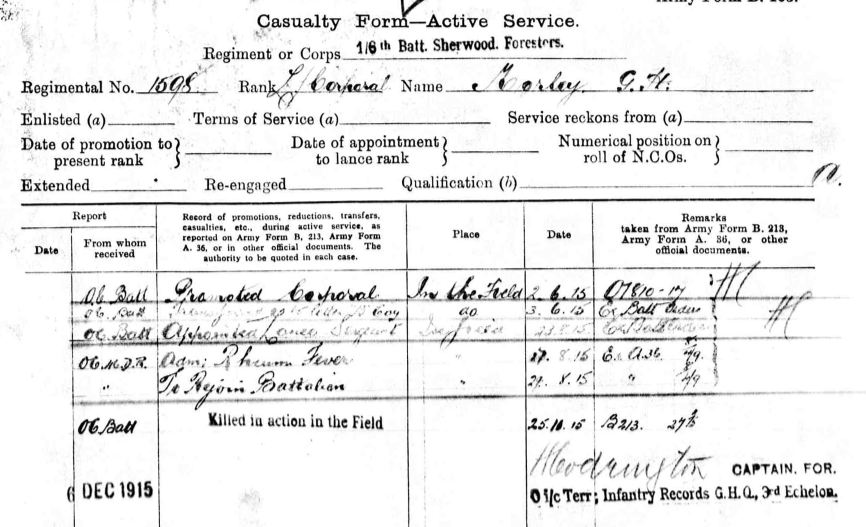
- 2343 Corporal Arthur Simpson A resident of Chapel-en-le-Frith he was the son of William Simpson of 34 Guernsey Rd., Lowfields, Sheffield. Arthur enlisted in September 1914 and arrived in France on the 28th February 1915. Arthur Simpson was a member of 5th Platoon, B Company and had played in the Cricket Match the previous summer.

St. Vaast Post Military Cemetery at Richebourg-l’avoue
All three men were buried next to each other in the closest trench cemetery. The strong point from which the Cemetery was named was in turn named from the hamlet of St. Vaast, between the village of Richebourg-St. Vaast and Goix-Barbee.

 It stands in an old orchard between two farm buildings where a trench tramway had its terminus and a Dressing Station was established. It was begun in May 1915 at the time of the Battle of Festubert and used by fighting units and Field Ambulances until July 1917.
It stands in an old orchard between two farm buildings where a trench tramway had its terminus and a Dressing Station was established. It was begun in May 1915 at the time of the Battle of Festubert and used by fighting units and Field Ambulances until July 1917.

 St. Vaast Post Military Cemetery at Richebourg-L’Avoue and the row of ‘Sherwoods’.
St. Vaast Post Military Cemetery at Richebourg-L’Avoue and the row of ‘Sherwoods’.
Amongst the men wounded during that trench tour (23rd – 25th November) were:-
- 3403 Alfred Bingley (A Company) enlisted in October 1914 and arrived in France with the III Reinforcement in August 1915. Later served with the Royal Army Medical Corps.
- 773 Percy Green (B Company) and a calico print from New Mills. Percy was a pre-War Territorial who had enlisted in October 1908 and arrived in France with the 46th Division in February 1915.

- 2303 John Lovatt Knight (B Company) aged 21 and a motor body maker from Bakewell. John enlisted in September 1914 and arrived in France with the 1st Reserve Reinforcement in June 1915. He was to suffer from shell shock in June 1917 and was killed in action later that year.

- 2742 Harold Baker (D Company) enlisted in October 1914 and arrived in France with the 46th Division in February 1915. He was discharged in July 1916 due to wounds and awarded the Silver Wound Badge.
- 3356 Charles Pepperday (D Company) a miner pony driver from Clay Cross. Charles enlisted in October 1914 and arrived in France with the 46th Division in February 1915. He later served with the Army Service Corps.
- 3646 Wilfred Fowkes (D Company) a coal mine pony driver from Chesterfield. Wilfred enlisted in January 1915 and arrived in France with the V Reinforcement in November 1915. He was discharged in August 1916 due to wounds and awarded the Silver Wound Badge.
- 2053 Bert Birley a labourer from Bakewell and a pre-War Territorial in “D” Company was taken ill.

- 2963 George Neale a gardener suffered a GSW in the left foot.
21st Trench Duty 30th November – 3rd December 1915
On the last day of November the Battalion relieved the 7th Sherwood Foresters in the right sector trenches. At this time the War Diary records that Major John Eaton Blackwall was promoted to Temporary Lieutenant Colonel and took Command of the 8th Sherwood Foresters.
On the 3rd December the Battalion was relieved by the 9th Welsh Regiment and the Sherwood Foresters Brigade went into billets at Robecq. The 46th Division had received orders to proceed to Egypt and was withdrawn into reserve, first at Robecq and then later moving to Boeseghem where they celebrated Christmas.
Sick and wounded included:-
During December the Battalion received several Officers and drafts of men from the 2nd and 9th Entrenching Battalions and from the Regimental Base:-
- 2/Lt Roland Walker Cash (6.12.15) and 53 other ranks (7.12.15) from 2nd and 9th Entrenching Battalions.
- 2/Lt Gordon Fraser Gardner and drafts of 13 (8.12.15) and 57 (12.12.15) other ranks from base.
On the 11th December the Battn received Christmas gifts collected from the good citizens of Nottingham. Many of the men received Christmas food parcels from home and with a generous rum issue most of the men remembered ‘Christmas 1915’ for many years to come.
On 25th December the men received their Christmas dinner whilst at Boeseghem, part of which had been paid for by the 2nd Sherwood Foresters. As part of the Christmas festivities the Battalion attended a church parade in the morning and in the afternoon played inter-company football matches. The following day the Battalion marched to billets in Isbergues and it was here that 6953 Company Sergeant Major Ernest Brown received notification that he had been promoted to 2nd Lieutenant and attached to the 2nd Sherwood Foresters.





Full of admiration for the range of details here. You’ve made it so accessible in terms of the visual content. Thank you. My great uncle (Lieutenant Ivan Vesey Townsend of 2 East Lancs) was KIA at Port Arthur in February 1915 and according to the Casualty Form was buried at Richebourg St Vaast (Windy Corner). A post-war letter said he was buried at Edward Road Cemetary No. 2, Richebourg L’Avoue. Do you know if these are one and the same? Perhaps the St Vaast cemetary above is one of these? He was later buried at the Cabaret-Rouge Cemetary in Souchez which I visited 3 years ago.
There’s so much here in your Richebourg section that’s relevant to what I know about Ivan’s time at the front – the shallow trenches, the breastworks (which I hadn’t visualised), Windy Corner etc. Thank you again. I wish I’d seen your website before that visit!
One last thing – could you point me in the right direction for the maps? I know MacMaster and NLS – do you have other sources?
Best wishes,
Mike
Mike, many thanks for your comments – glad you like the site. I think you’re right that Windy Corner and Edward Road are the same. As for the maps I have taken some from the 7th & 8th Battalion Histories and the others are the National Archive trench maps from the Naval & Military Press DVD. If there is any in particular I can email them to you, cheers Mike.